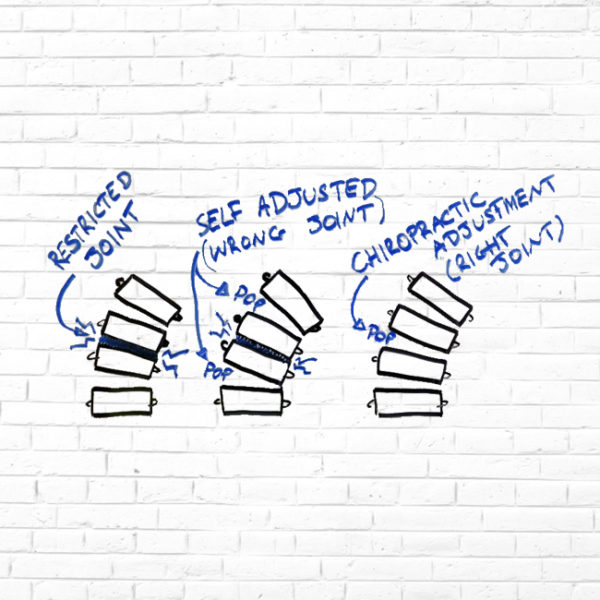So what’s the real difference between getting adjusted and cracking your own back? They usually sound the same and sometimes feel the same too. In fact, sometimes when you crack your own back it actually feels better. So, what’s the difference?
First off, many people put a lot of emphasis on the “cracking” sound which really has no bearing on whether or not a chiropractic adjustment was successful. It does however seem to be a reassuring sound to people that something has been accomplished. So it makes sense that when bending a certain way and hearing a “pop” people will assume something of significance has happened in their spine. The truth is, that sound you hear is called a cavitation and is the sound of gas escaping from the joint as it is opened or gapped. Our goal as chiropractors isn’t to open a joint enough to make a sound, but rather restore normal function to a joint with a very specific adjustment. It just so happens that many times as we are making that correction to the spine that it opens the joints of the vertebra enough to cause a cavitation. There are many times though that a correction can be and is made without enough force or movement to gap the joint. Usually, what we see is that the joints that people are “cracking” are joints above or below the actual problem that have become hypermobile, are moving too much. The reason they are moving too much is because the one with the problem isn’t moving enough and your spine is trying to make up for the lost motion by allowing other joints around it to move a little more than usual. These hypermobile joints are typically easy to get a good “crack” out of.

So, why does it feel good? The most common reason people crack their own back is because it offers some sort of relief. And there is a reason for this. When you crack your own back, along with the release of nitrous oxide gas from the joint, you are also stimulating mechanoreceptors, sensory receptors that respond to mechanical pressure or distortion and override pain receptors. You also release endorphins, which will give you a brief sense of euphoria, making you believe you have cured your problem. Unfortunately, the pain will likely return about 20 minutes later and you will feel the need to continue to “adjust” yourself every 20 minutes for relief. This only make the joints more hypermobile and therefore more difficult to maintain stability in the future. So even though it may feel good, it doesn’t mean it’s doing you any good. In fact, the feeling of the needing to constantly “pop” your neck or back is probably a good indicator that you have an underlying problem that needs to be corrected by a chiropractor.
One of the biggest differences between cracking your own back and getting a specific chiropractic adjustment is just that, it’s specific. Chiropractors are looking specifically for that one vertebra or joint that is not functioning properly and has become subluxated. Once they find it they use a specific amount of force in a specific lined of drive to deliver a specific correction by contacting a specific part of the bone with a specific part of their hand or finger. The Gonstead method, which we utilize in our practice, is based on this specificity not only in how we adjust the spine but also how we analyze and examine the spine to find out exactly where the primary problem is located.
So while it might feel good to find the biggest guy in the room and have him bear hug you and jump up and down a few times, you’re typically just working around an underlying problem and putting off correcting it. The “pop” may sound nice, but fixing the problem for good with chiropractic care sounds a lot nicer to me.





